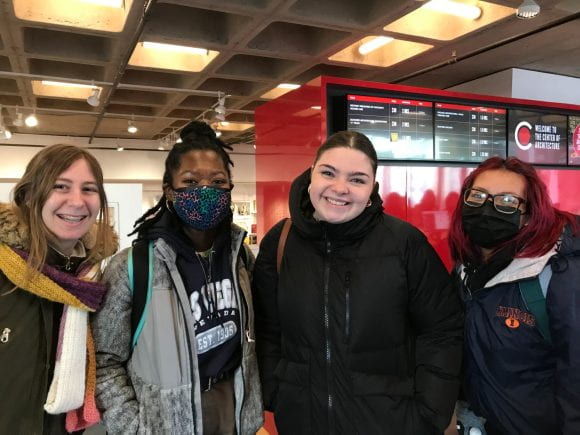 In celebration of Earth Day, our Honors SUST250 students headed south for an excursion to Wooden Island! Rather than being inside, our students enjoyed the beautiful weather and did some hands-on learning about Earth Day and Chicago’s rich urban nature landscape.
In celebration of Earth Day, our Honors SUST250 students headed south for an excursion to Wooden Island! Rather than being inside, our students enjoyed the beautiful weather and did some hands-on learning about Earth Day and Chicago’s rich urban nature landscape.
A Hidden Oasis: Wooden Island and the Japanese Gardens
As true Chicago students, we took a 30-minute bus ride south to Stony Island and 63rd. As we travelled, we took in Chicago’s rich urban landscape. From the city noises to tall skyscrapers and waves of people and cars, we have become accustomed to the busyness of city life. We couldn’t help but notice the differences as they started appearing on our ride to the park. Although just a few miles away, it felt like city life subsided to the quiet background. We crossed the street, and the cherry blossom trees, now blooming unlike last year, greeted us, swaying through the soft wind.
Walking across the red gravel pathways that curve through the park, we made our way to the Japanese Gardens. Students had the chance to explore and interact with the nature around us! The perfectly manicured bonsai trees, koi pond, and lagoon were favorites, along with the small (but steep!) wooden bridge. Afterwards, we came together and reflected on the beauty of this small garden as the Canadian Geese honked in the background. Professor Bryson offered insights on the location: it is one of the best spots in North American for bird watching, especially now through migration season!
Professor Bryson’s insights also helped us learn more about the history of Wooden Island. The development of Jackson Park reaches back to Chicago’s Great World’s Fair of 1893 where the city established itself with modern innovations and large buildings. Wooden Island was crafted by landscape architects Frederick Law Olmsted and Calvert Vaux, who wanted to create a park centered on natural aspects. As we reflected on this as a class, we thought about the aspects of the park that make it so unique. We noted the importance of detail, making sure that each aspect of the park blends seamlessly together like the water and curved pathways. All this works together to mimic natural landscapes. This hidden oasis provided a perfect location to learn about our landscapes, explore nature, and join Earth Day celebrations.
SUST250 Students: Stewards of the Land
As we walked through our field trip, we were tasked with picking up any trash we could find. With plastic buckets and long grabbers, we worked together to clean up the park. Although it was relatively clean, our eyes were not oblivious to small candy wrappers and pieces of Styrofoam. From small wrappers to glass bottles and even a bouquet of dead flowers, our class was determined to leave the park cleaner than when we arrived. Some students were brave enough to get close to the water and stretch far to pick up plastic bags and packaging!
We also learned a bit about Chicago’s recycling rules, as we were separating garbage and recycling. Much of the trash we picked up was non-recyclable plastic packaging, plastic bags, and glass. We reflected on consumption patterns and the invasiveness of plastic in our environment. Styrofoam was also most prevalent, especially in tiny hard-to-spot pieces, because it does not decompose but rather breaks down into smaller pieces, polluting our environment. Throughout this field trip, students thought about our consumption patterns especially in relation to single-use plastic and reflected on the importance of more sustainable alternatives.
This Honors class excursion provided us with hands-on learning experiences, where we interacted with our environment, contributing to our academic enrichment. We learned about sustainability-related topics, like waste and consumption, through actions and conversations, and reflected consistently throughout the field trip!
Sources:























